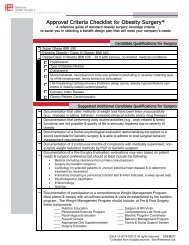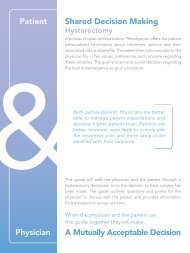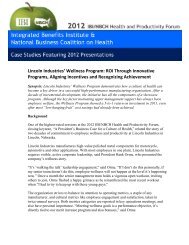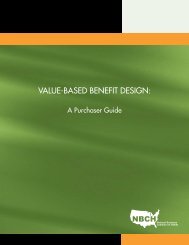Obesity/Weight Management Employer Survey and Interview Project
Obesity/Weight Management Employer Survey and Interview Project
Obesity/Weight Management Employer Survey and Interview Project
- No tags were found...
Create successful ePaper yourself
Turn your PDF publications into a flip-book with our unique Google optimized e-Paper software.
then move on to successful ways to address weightmanagement <strong>and</strong> what resources are available at theworksite, within the health plan services, EAP, <strong>and</strong>in the community. Have a champion (respected <strong>and</strong>influential person) speak from experience if possible.Organizations with fewer than 100 employees needcommunity-based programs since they do not havestaff to devote to this issue.A central resource such as an RN with the coalitioncould also provide support. Another outreach toemployers might be a shared resource for healthassessments, with biometric measures that includean extensive lab report with enzyme tests <strong>and</strong> othersbeyond the normal cholesterol, etc.12. Think for a moment about the main sourcesof obesity-related information you chose inthe survey why did you seek out this sourceof information (e.g., referred to it by another,credible source, existing relationship)?Information sources include NBCH, CDC, health plans,<strong>and</strong> public health. For employees, we found in oursurvey that their information sources are:Source Respondents %Doctors or Medical ProfessionalsRelativeFriendCo-workerWebsiteTelevisionCommunity ResourcesYour <strong>Employer</strong>Health Plan54.5%46.3%44.8%42.6%95.5%7.2%60.4%43.2%34.6%13. The survey indicated that very few employerspolled are actively working with communitybasedorganizations around obesity <strong>and</strong> healthissues. Has your organization formed partnershipsaround employee health generally <strong>and</strong>/or obesityspecifically?Our coalition is very engaged with other communitybasedorganizations <strong>and</strong> has been for years. This is aclose community <strong>and</strong> we work effectively together. Wereally need to have the senior management <strong>and</strong> businessleadership underst<strong>and</strong> the benefits to the community<strong>and</strong> their individual businesses that collective actionwould bring. The community is small enough to knoweach other. Additionally, we have worked togetherthrough a HRSA grant <strong>and</strong> we have a “one stop” accesspoint for all human services information <strong>and</strong> referrals.This includes a Medicaid evaluator that quickly assesseswhether an individual is eligible for Medicaid. Thecounty is also working on tracking the impacts to thecommunity. The coalition director spends 25% of hertime engaged in <strong>and</strong> representing employers in thesecommunity groups <strong>and</strong> initiatives. The community alsoworks on health measures every 3 years <strong>and</strong> has datacollected through the school physicals program on theobesity by the school.<strong>Employer</strong> B <strong>Interview</strong>14. Could you begin by telling us a little more aboutyourself?The interviewee is an Environmental Safety Specialist,Environmental Health <strong>and</strong> Safety Department at alarge university in the southern United States. Thecampus size is over 5500 acres with an undergraduatestudent population of 39,000 students <strong>and</strong> graduatepopulation of 9,400 students. Other campuslocations are in the state <strong>and</strong> outside the UnitedStates. Approximately 1,900 men <strong>and</strong> women servein a uniformed Corps of Cadets. There are 16,000employees. The community where the main campus islocated has a population of about 170,000.The <strong>Interview</strong>ee is an environmental safety specialistwith accident investigation skills as well as CPR <strong>and</strong>first aid training skills. Primary responsibilities focus onoccupational safety <strong>and</strong> not health. The organizationalstructure for programs that impact health is led bythe risk management function with human resourcesfor the benefit programs. Much of the focus for riskmanagement has been on biological safety with thelabs <strong>and</strong> campus-based research programs. Riskmanagement controls the funding for programsrelated to health. The Environmental Health <strong>and</strong> SafetyDepartment has developed safety teams <strong>and</strong> focusedon worksite injuries with over 3000 workers targetedas high risk jobs.15. Did you consult with others to complete theonline survey? No16. Tell me about your obesity prevention program.The University does not have an obesity program orany wellness program. The logistics of the campus68National Business Coalition on Health









